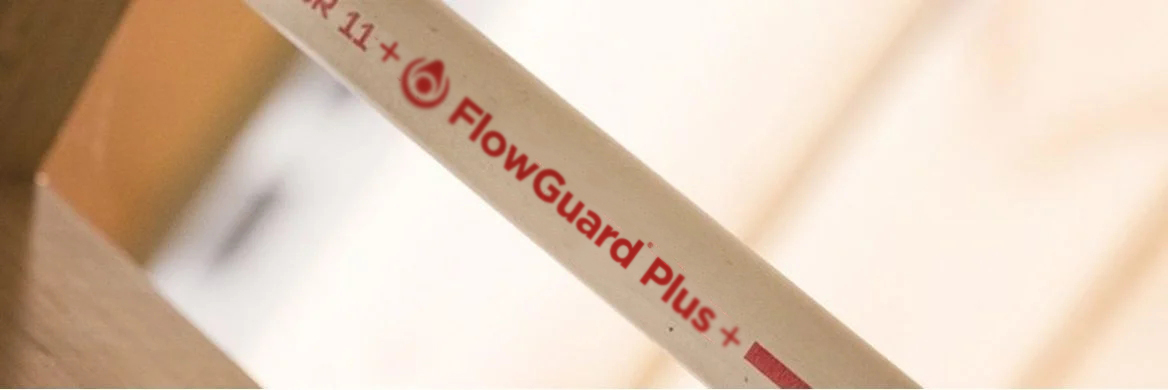
FlowGuard Plus CPVC For External Potable Water Lines
FlowGuard Plus is the world’s No. 1 CPVC plumbing system and has been a source of safe, clean water for millions since 1960. CPVC pipes, in comparison to standard PVC pipes, are superior as they can withstand greater temperature and pressure and are suitable for both cold and hot water systems. One of the most popular uses of CPVC is as a residential water pipe. Since CPVC pipes are considered the best-in-class to transport potable water, you must know everything in detail about them. In this blog, let us discuss everything from A to Z about CPVC outdoor plumbing systems.
Installation of CPVC Outdoor Potable Water Lines
While still under construction, you must ensure that your outdoor potable water line, especially, are from a trusted source such as us. FlowGuard Plus is easy to install and requires no heavy equipment, electricity or heat for installation. Let us learn how to install the FlowGuard Plus CPVC outdoor underground pipe:
- Cut the pipe: FlowGuard Plus CPVC pipes can be cut with ratchet cutters, wheel cutters, or perhaps even a fine-tooth saw. Begin by making a visible mark on the pipe length. Make sure the pipe and fittings are the same size. To obtain an optimal bonding area, you must cut the pipe squarely. Before joining pipe ends, you must thoroughly inspect them. If you notice a crack or splintering, cut off at least 25 mm beyond the visible crack. *Pro tip: Ratchet cutters should not be used on previously installed pipes.
- Prepare the pipe and fittings: Remove burrs both inside and outside the pipe end for a smooth flow and proper fitting socket contact during assembly. You can use a half-round file, pen knife, or deburring tool with a 15-mm diameter to do so. A slight bevel on the pipe end will make it easier to fit into the fitting socket.
- Fitting preparation: Wipe the dirt as well as moisture from the fitting sockets and pipe ends with a clean, dry rag. Make a visible marking with a felt-tip pen after dry-fitting the pipe to ensure perfect fitting.
- The one-step solvent cement process: To ensure an optimal solvent weld joint, use FlowGuard® Plus CPVC Solvent Cement that meets ASTM F-493 specifications. Apply a uniform layer of solvent cement to the end of the pipe as well as inside the fitting socket as you create a joint. Remember, you must not use thickened or lumpy solvent cement. It should have a smooth, flowing consistency like syrup or paint.
- Assemble the pipes and fittings: Insert the pipe instantly into the fitting socket, rotating it 1/4 to 1/2 turn during insertion to evenly distribute the solvent cement. Using the patented alignment system, align the fittings. Hold the assembly in place for about 30 seconds to allow the joint to set and prevent push-out. Make a bead of one-step solvent cement around the opening of the socket fitting. Using a clean, dry cloth, remove any excess solvent cement from the pipe and fitting. Voila! You are done!
Benefits of CPVC for Outdoor Potable Water Lines
There are several benefits to using CPVC outdoor potable water lines. These include:
- Resistance to high temperatures
- High corrosion resistance
- Can withstand wear and tear
- UV Resistant
- Biofilm Formation Resistant
Why Choose FlowGuard Plus CPVC Pipes?
FlowGuard Plus is the world’s No. 1 CPVC plumbing system and has been a source of safe, clean water for millions since 1960. FlowGuard Plus CPVC pipes are made using the best-quality, durable material that has features such as biofilm resistance, fire resistance, no chlorine impact, and suitability for water temperatures of up to 92°C, making it the best pick for potable water supply in your homes.
Frequently Asked Questions on Outdoor Cold Water Lines
- Can CPVC pipe be used outdoors?
Yes, it can be used for both cold and hot water systems. That is, it can be used both inside and outside your home for potable water applications. - Can CPVC withstand cold temperatures?
Yes, CPVC can withstand cold temperatures. - What is the best pipe for an outdoor potable water line?
The FlowGuard Plus CPVC pipe is the best pipe for house plumbing in India. As the pioneer in CPVC technology, FlowGuard® Plus offers superior water quality, chlorine resistance, biofilm resistance, fire resistance, durable, and cost-effective

Prasenjit Misra
Prasenjit Misra, an accomplished professional, having extensive exposure in plumbing field, currently holds the position of Lead Demand Creation & Business Development of TempRite South Asia division at Lubrizol India.
